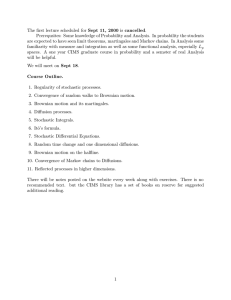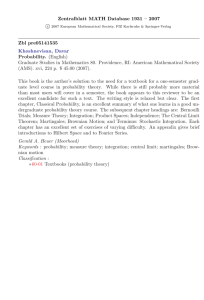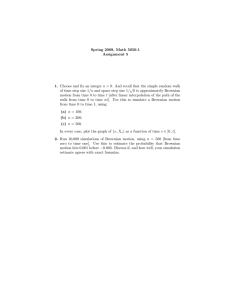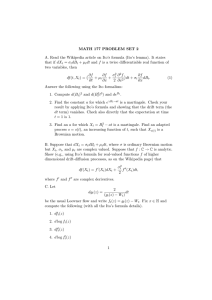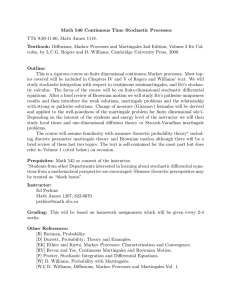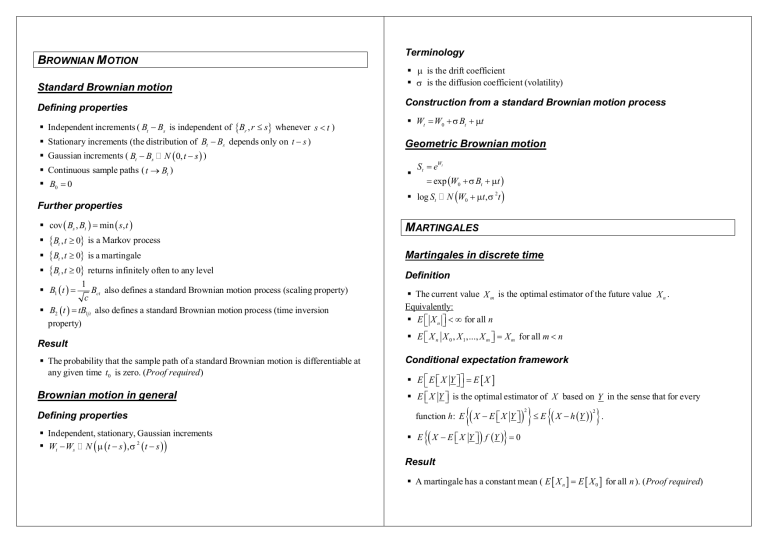
BROWNIAN M OTION
Standard Brownian motion
Defining properties
Terminology
§ µ is the drift coefficient
§ σ is the diffusion coefficient (volatility)
Construction from a standard Brownian motion process
§ Independent increments ( Bt − Bs is independent of {Br , r ≤ s} whenever s < t )
§ Wt = W0 + σ Bt + µt
§ Stationary increments (the distribution of Bt − Bs depends only on t − s )
Geometric Brownian motion
§ Continuous sample paths ( t → Bt )
§ B0 = 0
§
§ Gaussian increments ( Bt − Bs : N ( 0, t − s ) )
Further properties
§ cov ( Bs , Bt ) = min ( s, t )
§
§
§
{Bt , t ≥ 0} is a Markov process
{Bt , t ≥ 0} is a martingale
{Bt , t ≥ 0} returns infinitely often to any level
1
Bct also defines a standard Brownian motion process (scaling property)
§ B1 ( t ) =
c
§ B2 (t ) = tB1 t also defines a standard Brownian motion process (time inversion
property)
Result
§ The probability that the sample path of a standard Brownian motion is differentiable at
any given time t0 is zero. (Proof required)
Brownian motion in general
Defining properties
§ Independent, stationary, Gaussian increments
§ Wt − Ws : N ( µ ( t − s ) , σ 2 ( t − s ) )
St = eWt
= exp (W0 + σ Bt + µt )
§ log St : N (W0 + µt ,σ 2t )
MARTINGALES
Martingales in discrete time
Definition
§ The current value X m is the optimal estimator of the future value X n .
Equivalently:
§ E X n < ∞ for all n
§ E X n X 0 , X 1 ,..., X m = X m for all m < n
Conditional expectation framework
§ E E X Y = E [ X ]
§ E X Y is the optimal estimator of X based on Y in the sense that for every
function h: E
§ E
{( X − E X Y ) } ≤ E {( X − h (Y )) } . (Proof required)
2
2
{( X − E X Y ) f (Y )} = 0 (Proof required)
Result
§ A martingale has a constant mean ( E [ X n ] = E [ X 0 ] for all n ). (Proof required)
Martingales in continuous time
Properties
Definition
t
§ ∫ Ys dBs , t ≥ 0 is a martingale
0
t
§ E ∫ Ys dBs = 0
0
2
t
t
t
§ E ∫ Ys dBs = E ∫ Ys 2ds = ∫ E Ys 2 ds
0
0
0
§ E X t < ∞ for all t
§ E X t Fs = X s for all s < t
Filtration framework
§ The filtration of a stochastic process X t is denoted Ft , and is the set of all events in
the sample space that depend only on X s ,0 ≤ s ≤ t .
§ A random variable Y is Ft -measurable if the event {Y ≤ y} belongs to Ft for all
values of y.
§ A stochastic process Yt , t ≥ 0 is adapted to the filtration Ft if Yt is Ft -measurable for
all t.
0
Definition (general case)
{ }
§ If a sequence of step functions Ys( n) converges to the adapted integrand Ys , then the
t
sequence of integrals ∫ Ys ( n) dBs converges to the limit defined as ∫ Ys dBs .
0
0
t
§ This approach can be used for any Y satisfying E ∫ Ys 2 ds < ∞ .
0
§ The properties of the simple case (above) are preserved.
t
Results
§ E
t
§ The sample paths of ∫ Ys dBs are continuous
{( X − E X F )Y } = 0 for all F -measurable bounded Y
t
t
§ E E X Ft = E [ X ]
§ If X is Ft -measurable, then E X Ft = X
§ If Y is Ft -measurable and bounded, then E XY Ft = Y .E X Ft
§ If X is independent of Ft , then E X Ft = E [ X ]
STOCHASTIC CALCULUS
Ito integrals
Definition (simple case)
Y 0 ≤ s < t1
§ If Ys = 0
, where Y0 is F0 -measurable and Y1 is Ft1 -measurable, then:
Y1 t1 ≤ s ≤ T
t
if t < t1
Y0 Bt
§ ∫ Ys dBs =
0
Y0 Bt1 + Y1 ( Bt − Bt1 ) if t ≥ t1
Ito processes
Definition
A time-homogeneous diffusion (Ito) process has the following defining properties:
§ It is a Markov process
§ It has continuous sample paths
§ There exist functions µ ( x ) and σ 2 ( x ) > 0 such that as h → 0+
E X t +h − X t X t = x = hµ ( x ) + o ( h)
2
E ( X t +h − X t ) X t = x = hσ 2 ( x ) + o ( h )
3
E X t+h − X t X t = x = o (h )
§ Similar to a general Brownian motion, but with variable drift and diffusion
coefficients.
General results
Notation
t
t
0
0
§ An Ito process can be defined in integral notation as: X t = X 0 + ∫ Ys dBs + ∫ Z s ds
§ A shorthand form is to use differential notation: dX t = Yt dBt + Zt dt
t
t
§ M t = exp ∫ f ( s ) dBs − 12 ∫ f 2 ( s ) ds is a martingale
0
0
t
t 2
§ ∫ f ( s ) dBs : N 0, ∫ f ( s ) ds
0
0
Ito’s Lemma
Ornstein-Uhlenbeck process
Lemma for a function of standard Brownian motion
Stochastic differential equation
§ df ( Bt ) = f ′ ( Bt ) dBt + 12 f ′′ ( Bt ) dt
dX t = −γ X t dt + σ dBt
Lemma for a function of a diffusion process and time
∂f ∂f
∂f
∂2 f
§ df ( t , X t ) = Yt dBt + + Zt + 12 2 Yt 2 dt
∂x
∂x
∂t ∂x
§ Define U t = f ( t , X t ) = e γ t X t and use Ito’s lemma to calculate
§ Substitute for dX t and simplify
§ Express in integral form and then convert back to X t
Derivation
§ Taylor’s formula gives: df ( t , X t ) =
§ Substitute dX t = Yt dBt + Zt dt
∂f
∂f
∂2 f
2
dt + dX t + 12 2 ( dX t )
∂t
∂x
∂x
§ Use the fact that ( dt ) = dtdBt = dBt dt = 0 and ( dBt ) = dt
2
2
Geometric Brownian motion
Stochastic differential equation
§ dSt = σ St dBt + α St dt
Process to solve
§ Use Ito’s lemma to calculate d log St
§ Substitute for dSt and simplify
§ Express in integral form and then convert back from logs
Solution
§ St = S0 exp (α − 12 σ 2 ) t + σ Bt
§
(
St
: lognormal (α − 12 σ 2 ) t , σ 2t
S0
)
Process to solve
Solution
t
§ X t = X 0e −γ t + σ ∫ e −γ ( t − s) dBs
0
Properties
σ2
§ X t : N X 0e −γ t , (1 − e −2γ t )
2
γ
§ This process is the continuous equivalent of an AR(1) process.
THE CONTINUOUS TIME LOGNORMAL M ODEL
Definition
§ log Su − log St : N µ ( u − t ) , σ 2 ( u − t ) for u > t
Where:
§ St is the security price at time t
§ µ is the drift
§ σ is the volatility
Equivalently:
§ St = exp (W0 + σ Bt + µ t )
§ log Su = log St + µ ( u − t ) + ε uσ u − t
Momentum effects
§ Evidence of momentum effects is inconsistent with the independent increments
assumption
Non-normality of returns
§ Evidence suggests that there are more days with little or no movement in prices than
would be expected if log returns were normally distributed (higher peak)
§ Evidence suggests that there are more days with very large price movements than
would be expected if log returns were normally distributed (fatter tails)
STOCHASTIC MODELS OF ASSET PRICES ( CONTINUED)
Cross-sectional and longitudinal properties
Properties
Cross-sectional properties
§ Mean and variance of the log returns are proportional to u − t
§ Returns over non-overlapping intervals are assumed to be independent
§ E [ Su ] = St exp ( µ (u − t ) + 12 σ 2 ( u − t ))
§ Looks at the distribution over all simulations at a particular point in time
§ Dependent on the initial conditions
§ var [ Su ] = St2 exp ( 2µ ( u − t ) + σ 2 (u − t ) ) exp (σ 2 ( u − t ) ) − 1
Reasons why it may be inappropriate
Volatility
§ A constant σ is inconsistent with historically observed market volatility
§ Implied volatility in option prices has fluctuated significantly over time
Drift
§ It can be argued that µ should vary over time, particularly with interest rate changes
Mean reversion
§ Evidence of mean-reverting behaviour is inconsistent with the independent increments
assumption
Longitudinal properties
§ Looks at a statistic sampled from a single simulation over a long period of time
§ Based on an average over varying market conditions, not those at a particular date
Random walk
§ Because of the independent increments property, returns are independent over time
§ Cross-sectional and longitudinal simulations coincide (not true of other models)

